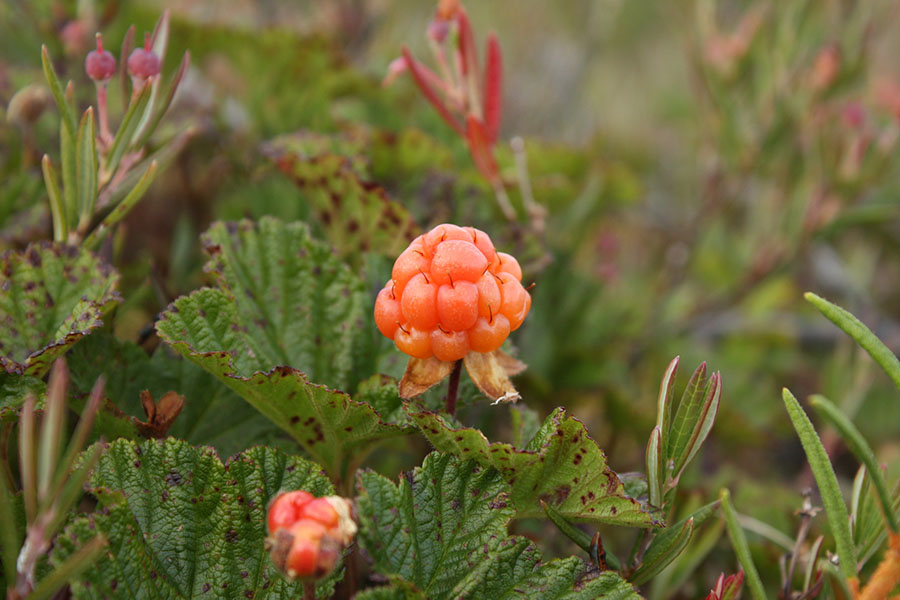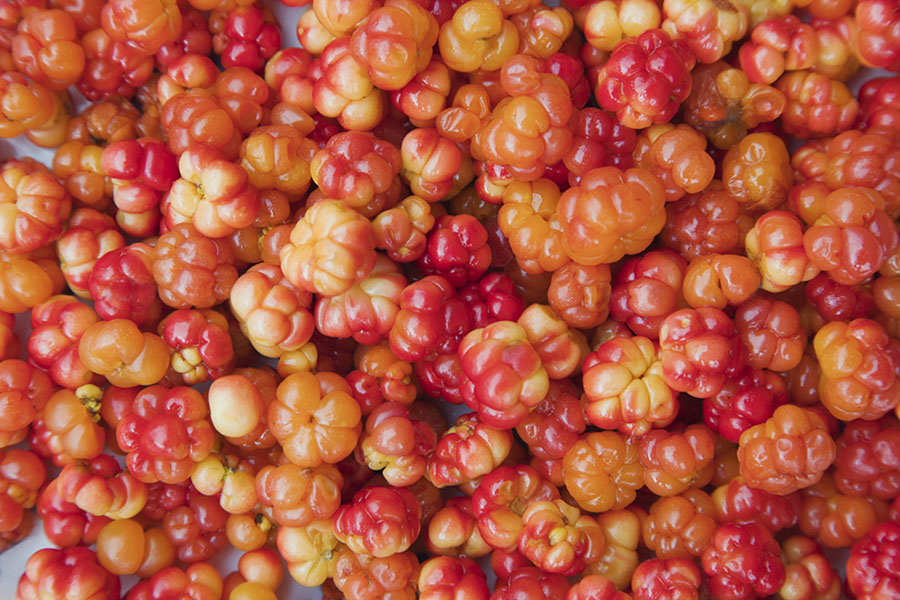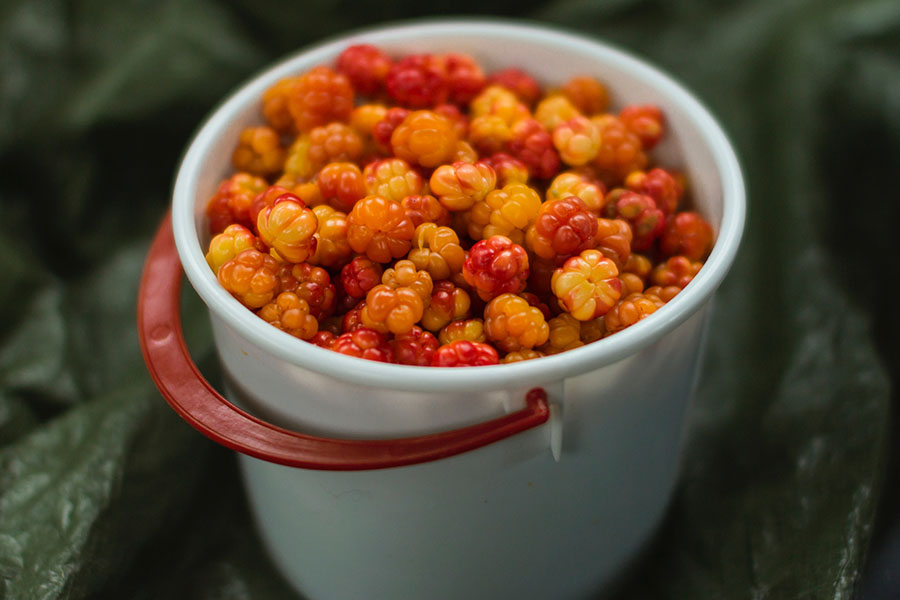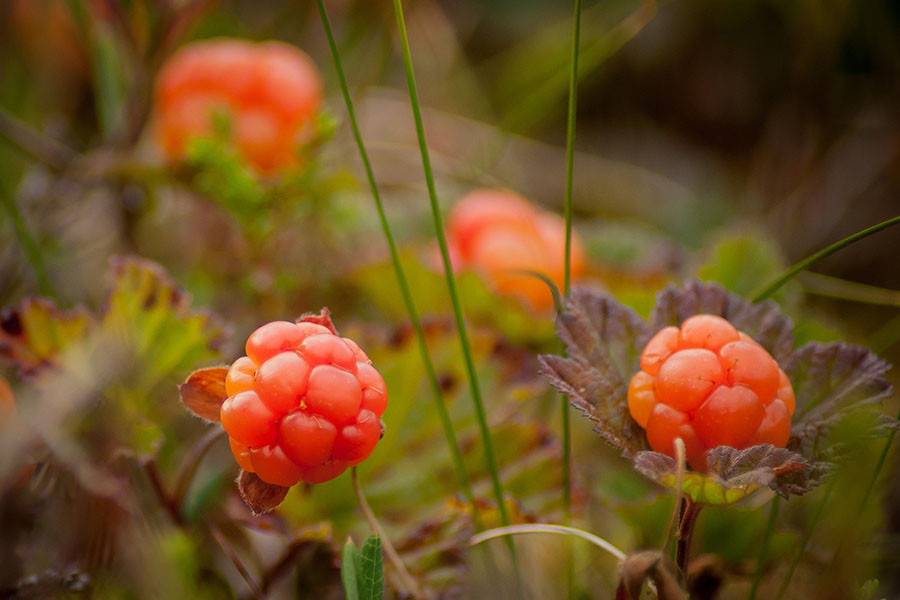Home > Alaska > Alaska Crops & Livestock > What Are Cloudberries?
What Are Cloudberries?

There are strawberries, blueberries, blackberries and raspberries – and then are berries that float high above all the rest, at least when it comes to the anomaly factor. We’re talking about cloudberries, and if that name doesn’t sound familiar, it’s because these are not your average grocery store fruits. In fact, these unusual berries are exclusively foraged, meaning you probably won’t find them at farmers markets, unless you’re visiting one of the few areas in which they grow – or happen to dine at a restaurant with a chef who’s savvy enough to source them.
See more: What is Sorghum?
What Are Cloudberries?
With an appearance similar to a raspberry and the color of a bright juicy orange, cloudberries – also known as bakeapples and low-bush salmonberries, depending on who you ask – are a rare treat. They grow almost exclusively in Norway, Sweden, Finland, Russia, Canada and Alaska. However, you may find these elusive gems in the contiguous United States if you’re willing to trek through the wilderness like Dan Mallahan.

The executive chef at Rider in Seattle first got acquainted with cloudberries about a decade ago while visiting his brother in Alaska. The berries were everywhere there, he says, so it was a pleasant surprise when he recently discovered them growing around areas like Mount Pilchuck, Mount Baker-Snoqualmie National Forest and the foothills of the North Cascades above 5,000 feet in Washington state.
They grow similar to a strawberry plant, Mallahan says, creating low ground cover in meadows or leading toward alpine lakes and streams. A perennial, they die down after the first frost but rejuvenate come spring, and are ready to harvest in early to mid-summer.
See more: What Is Yellow Watermelon?
How Are Cloudberries Used?
Flavor wise, cloudberries are tart and sweet – think the texture of a blackberry or raspberry but with fewer seeds, says Mallahan. When they are overripe, they take on an interesting texture change, becoming almost creamy like yogurt. But though they seem delicate, cloudberries are quite versatile in the kitchen.
“I love to use them fresh in desserts or salads, and they make a wonderful compote, jam or jelly for breakfast or [can be] paired with a full-bodied fish, [like] wild black cod or local king salmon,” says Mallahan. At Rider, bartenders have even used the berry muddled, floated fresh or turned into a syrup or infusion for cocktails.
Though he doesn’t live in an area where he can forage cloudberries himself, chef John Shields of Smyth in Chicago has discovered their magic through Canada-based Gourmet Sauvage, a company that purveys cloudberries and other unique finds grown in Quebec like milkweed salsa and ox-eye daisy capers. For a recent tasting menu, Shields accented a dish of Montana river trout with dressing made from charred onions and the juice of Canadian cloudberries.
See more: What Are Pawpaws? Discover the Tropical Fruit Growing Wild in Indiana

He describes the flavor as something so unique, you simply have to try it to understand –an impressive feat for such a humble berry. “Cloudberries are technically in the rose family and carry a distinct floral note,” Shields explains. “On their own, there are hints of raspberry, mango, apricot and passionfruit; we find that extracting the nectar brings flavors of yeast, citrus and concentrated watermelon.”
The Dark Tickle Company, located on the Great Northern Peninsula in Newfoundland, Canada, is also spreading the love for cloudberries, producing jams, sauces, vinegars, chocolates and more from rare hand-picked berries in their area. The company’s handmade dark chocolates filled with bakeapple ganache are a local legend – and come with a double dose of antioxidants.
Like strawberries and oranges, cloudberries are high in vitamin C, containing about 158 milligrams per 2/3 cup, according to a report from University of Alaska Fairbanks’ Cooperative Extension Service. The little orange gems also contain high levels of vitamins A and E, as well as antioxidants that can help prevent cellular damage from free radicals.
See more: Foods that Grow in Alaska
How to Use Cloudberries in Your Home Kitchen
If you’re able to get your hands on cloudberries of your own, there are many ways to cook and bake with them – you can simply sub them in for other kinds of berries in treats like shortcake or fresh berry pie. They freeze well, too (up to two years), if you spread them in a single layer on a cookie sheet and place in the freezer before transferring to freezer bags or containers. Or, you can simply use them as a tasty garnish, as John Sundstrom of Lark restaurant in Seattle does, since they are so rare.
Of course, no one would blame you for popping a handful of freshly picked berries straight into your mouth if you’re lucky enough to be able to forage for them in the Pacific Northwest or Alaska. They’re very juicy and fine to eat raw, according to the Cooperative Extension Service. They’re also a dream to make into jams, jellies and syrups. Or you could do as the Alaskans do and experiment making akutaq, a treat also known as Eskimo ice cream that’s made with whipped animal fat, sugar and berries.






Excellent article on cloudberries not only answering my question about what cloudberries were, but giving a thoughtful explanation of both where they are found, what they taste like including hints of flavors, and how to use them. I look forward to trying them for the first time.
[…] The berries were everywhere there, he says, so it was a pleasant surprise when he recently discovered them growing around areas like Mount Pilchuck, Mount Baker-Snoqualmie National Forest and the foothills of the North Cascades above 5,000 feet in Washington state. via […]
Slight correction. Finland is not part of Scandinavia. It’s Norway, Sweden and Denmark. Cloudberries are also available in Sweden.
The page you have created is very beautiful and it must not have been so easy, you must have found it very difficult because it is not an easy task to write your thoughts in words, I love your written words, keep writing in the same way.
[…] https://www.farmflavor.com/alaska/alaska-crops-livestock/what-are-cloudberries/ […]